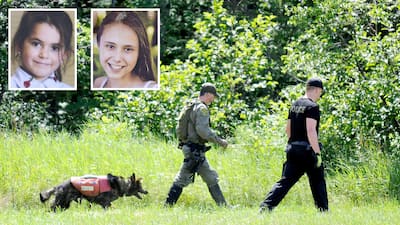The Haunting Tragedy of Norah and Romy Carpentier: A Father’s Betrayal and the Mystery of Their Final Hours 3124c
It began as an ordinary summer evening — a quick outing for ice cream, a promise to be home by 9 p.m., and a father spending what should have been a simple, carefree moment with his two daughters. Nothing about that night hinted at the terror, the confusion, and the heartbreak that would soon consume an entire nation. And yet, within a span of hours, a family’s world would unravel in a way so disturbing that even seasoned investigators struggled to comprehend it.
This is the haunting story of Norah and Romy Carpentier — two young sisters whose final hours remain among the most chilling family tragedies in recent memory. It is a story of fear disguised as love, of a father drowning beneath pressure, and of two children who trusted him completely until the very end.
And behind that story lies one pressing, painful question:
What truly happened in those woods?

A Night That Should Have Been Ordinary
On July 8th, 2020, Martin Carpentier asked to take his daughters — Norah, 11, and Romy, 6 — out alone. They had dinner as a family earlier that evening, a moment their relatives would later recall with a heaviness that words cannot fully capture. Nothing seemed unusual. Nothing felt dangerous. It was just a father and his girls leaving the house for ice cream.
He told their mother he would be back by 9 p.m.
But 9 p.m. passed.
Then midnight.
Then dawn.
And by the next morning, the sense of unease had hardened into terror.

The Crash That Wasn’t an Accident
Hours after the trio disappeared, their car was found wrecked along the highway — but the scene didn’t match the typical chaos of a sudden accident. The airbags deployed. The vehicle was damaged. Yet there were no victims at the site. No footprints indicating panic or injury. No attempts to seek help.
Instead, it appeared as though all three had walked away deliberately.
When authorities reconstructed the crash, the patterns of movement were shocking: the steering, the trajectory, the speed — all of it pointed to an intentional act.
Martin Carpentier, investigators later concluded, had tried to kill himself and his daughters that night.
But the attempt failed.
And what followed was even worse.

The Amber Alert That Shook Quebec
By July 9th, an Amber Alert was issued — one of the largest, most intense searches the province had ever seen. Police officers, helicopters, rescue dogs, and volunteers combed the dense forests with an urgency fueled by dread. Families across Quebec kept their children close as the story unfolded on every screen, every radio, every front page.
Three people were missing.
A father.
And two little girls with bright smiles and their entire lives ahead of them.
For days, all anyone could do was hope.
But hope would not be enough.

July 11th: The Discovery That Ended the Search
Three days after the crash, deep in the woods, the bodies of Norah and Romy were found.
Their final moments were disturbing, heartbreaking, and full of questions that may never be fully answered. According to the coroner, the girls had walked into the forest with their father — a father they trusted, a father they looked up to, a father they believed would keep them safe.
At some point during that walk, he attacked them.
Not with a weapon.
Not with a plan.
But with a branch he found in the woods.
A quiet, remote patch of forest became the final resting place of two innocent children who never should have been there in the first place.

A Trigger Years in the Making
Why did he do it?
What could possibly drive a father to such an unthinkable act?
Investigators traced the unraveling back five years — to the moment Martin and the girls’ mother separated. Though the separation was amicable, something inside him never healed. Over time, his fear of losing his daughters grew into an obsession.
On the very day he disappeared with them, his lawyer emailed him divorce documents for approval.
The coroner later stated that receiving that email was the breaking point — the trigger that pushed him past the edge of rational thought.
He spent the afternoon with his family, ate dinner as though everything were normal, then took his daughters for ice cream… knowing he would never bring them home.

Nine Days Later: The Father’s Body Is Found
After Norah and Romy were discovered, the search shifted to one final person: Martin Carpentier.
Where was he?
Was he alive?
Was he running?
It took nine more days before his body was found — alone in the forest, not far from where the girls had been discovered. The cause of death was consistent with suicide.
A broken man, an irreversible act, and a community left with more grief than answers.

The Questions That Still Haunt This Case
Even with the timeline reconstructed, even with evidence analyzed, even with a coroner’s report completed, one truth remains:
there is no explanation that can make sense of what happened.
Why didn’t he seek help?
Why didn’t anyone see the signs?
Why did two young girls have to lose their lives to the weight of an adult’s despair?
Those who knew the family described the sisters as joyful, energetic, deeply loved — not just by their mother, but by their father too. And that contradiction is what makes this tragedy so incomprehensible.
How can love and destruction coexist inside one person?
How can fear twist itself into something deadly?
How can a simple evening outing end in horror?
These are the questions that linger.
These are the questions that keep this story alive.

A Tragedy Impossible to Forget
Norah and Romy Carpentier were not just names in a headline. They were two children who loved drawing, music, laughter, and the simple joys of being young. They had birthdays ahead. School years ahead. Futures ahead.
But their lives were stolen by the one person who should have protected them above all else.
Their mother, their community, and countless strangers who followed the case continue to grieve them — two sisters whose story still echoes with sadness, disbelief, and the unbearable weight of what could have been.
The forest where they took their last steps remains quiet now.
But the questions… the heartbreak… the haunting mystery of that night…
Those remain.
Because the story of Norah and Romy is not just about what happened.
It’s about why it happened — and why the world still cannot look away.
The Little Fighter: How Elsie’s First Years Became a Testament to Survival and Grace 1214

At just two years and nine months old, Elsie is a blur of motion. She runs, she climbs, she swims, she explores with the boundless energy of a child who seems to have no interest in slowing down. She adores the outdoors, animals, and the water. To anyone meeting her now, she looks like any other lively toddler discovering the world. But behind her bright eyes and quick steps lies a journey of survival that has already tested her more than most people endure in a lifetime.

Elsie was born on October 15, 2022. Her entrance into the world was not gentle, and from the very first moment, both she and her mother, Clara, were thrust into a fight for their lives. Clara developed eclampsia late in pregnancy — a dangerous complication that caused severe seizures just before delivery. Doctors acted quickly, delivering Elsie at just 35 weeks. She weighed barely five pounds, tiny even by preemie standards. It was the kind of fragile beginning that could have been the start of tragedy. But instead, it became the beginning of a miracle.
Within two and a half weeks of her birth, Elsie underwent open-heart surgery. She had been diagnosed with TAPVR — Total Anomalous Pulmonary Venous Return — a rare congenital heart defect in which the veins that return blood from the lungs connect to the wrong place in the heart. Without surgical correction, TAPVR can be fatal. For Clara, the knowledge was devastating. She had barely had time to hold her newborn when she was told her baby needed major surgery to live.

Those first weeks were a blur of monitors, alarms, and whispered prayers. Doctors worked meticulously, opening the chest of a baby barely the size of a football, repairing her heart so that it could pump blood correctly. Clara, still recovering from her own seizures and complications, hovered between gratitude and fear. Every beeping machine was a reminder of how fragile the line between life and loss could be.
But Elsie fought. Day by day, she surprised her doctors. Against all odds, her tiny heart learned to beat in rhythm. Her fragile body began to stabilize. And her mother, still grappling with the trauma of eclampsia, found strength in her daughter’s resilience.
The battles, however, were not over. Elsie developed lung complications and struggled to gain weight. Her heart rate dropped unexpectedly more than once, sending waves of fear through the family. In 2024, doctors diagnosed her with a mild case of arteritis — an inflammation of the arteries that added yet another hurdle to her already challenging path. Each diagnosis was another reminder that Elsie’s life would not be simple. But each time, she rallied. Each time, she reminded everyone watching that she was not a victim of circumstance — she was a fighter.

Today, nearly three years later, Elsie is thriving. She runs across the yard with her brother, Easton, her laughter echoing through the house. She is healthy, active, and full of joy. The scars on her chest are the only physical reminder of the surgeries and hospital stays that once defined her days. To Clara, every ordinary moment — every bite of food, every step taken, every giggle — feels extraordinary.
“I’m so thankful for Children’s of Alabama,” Clara says with heartfelt sincerity. The hospital became their lifeline, the place where doctors and nurses gave Elsie not just medical care, but a future. “And God is so good,” she adds, her voice thick with emotion. “I feel like the seizure I had was God’s way of intervening. Because of it, the doctors delivered Elsie early and found her heart problem right away. If I had carried to full term, it might have been too late.”

Clara’s perspective reframes what once seemed like tragedy into grace. What nearly cost her life may very well have saved her daughter’s. It is a perspective born not of blind optimism, but of walking through the valley of fear and finding light on the other side.
For the community of Ballplay, Alabama, where Clara raises her children, Elsie has become a living reminder that miracles still happen. Her story is proof that resilience can grow even in the tiniest of bodies, that faith can carry families through sleepless nights, and that the best news sometimes comes wrapped in the laughter of a child who was never supposed to make it this far.

Good news feels rare in a world so often overshadowed by headlines of loss and fear. But today, good news comes in the form of a little girl who runs and swims and never seems to stop moving. Good news comes in the form of a mother who can look back on seizures, surgeries, and scars and say with confidence: we made it. Good news comes in the form of Elsie’s beating heart, repaired by surgeons’ hands but sustained, her family believes, by something greater.
If you are searching for hope, it can be found in Ballplay, Alabama, in the smile of a little girl named Elsie. She is proof that storms can be survived, that prayers can be answered, and that miracles sometimes arrive disguised as tiny fighters who refuse to give up.

So let today’s story be a reminder. Hold your children close. Celebrate every ordinary moment, because sometimes the most ordinary things are the greatest gifts. And never stop believing that even in the darkest moments, light can break through.

Because Elsie is not just surviving. She is living — joyfully, energetically, and with a heart that was once broken but now beats stronger than ever.





